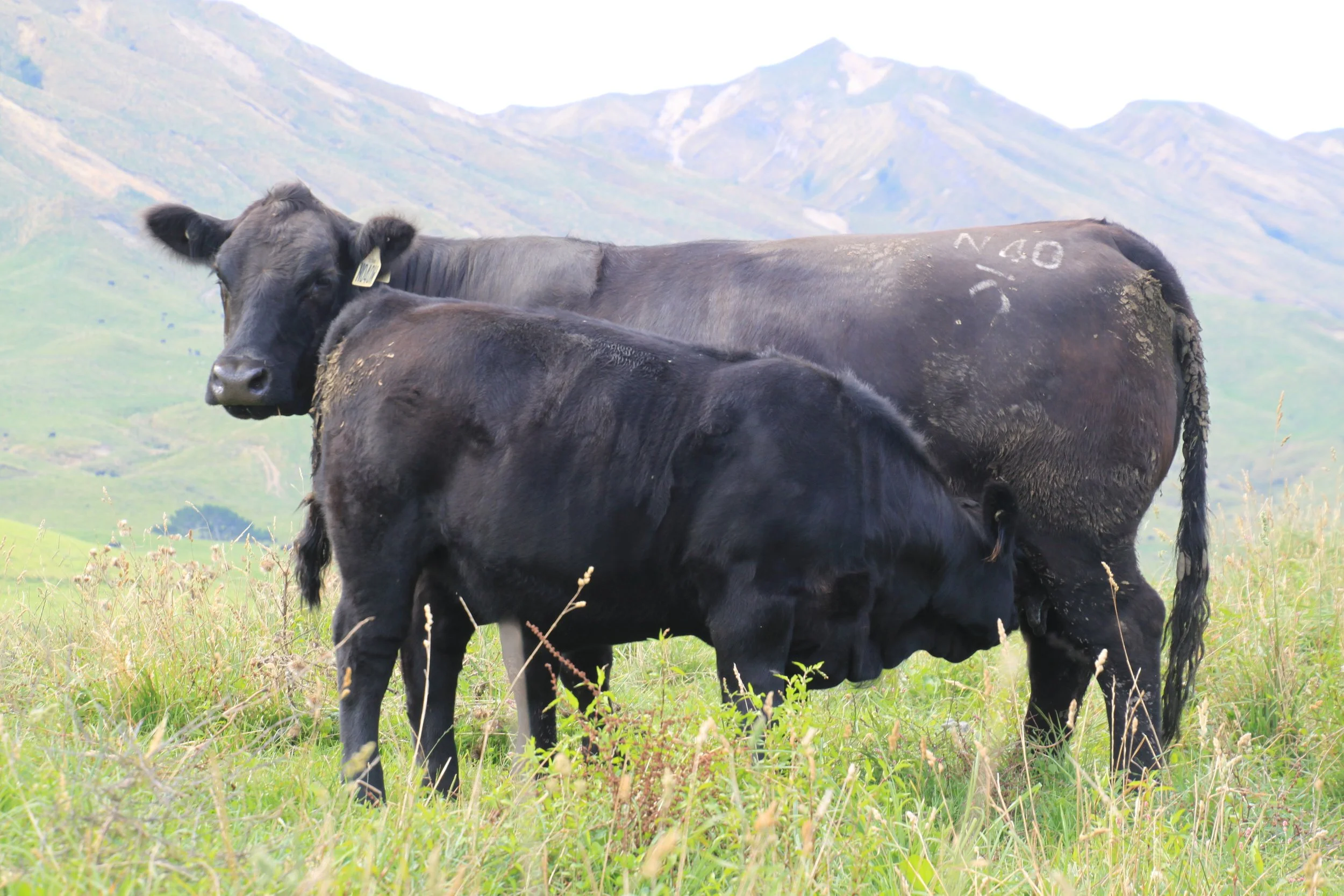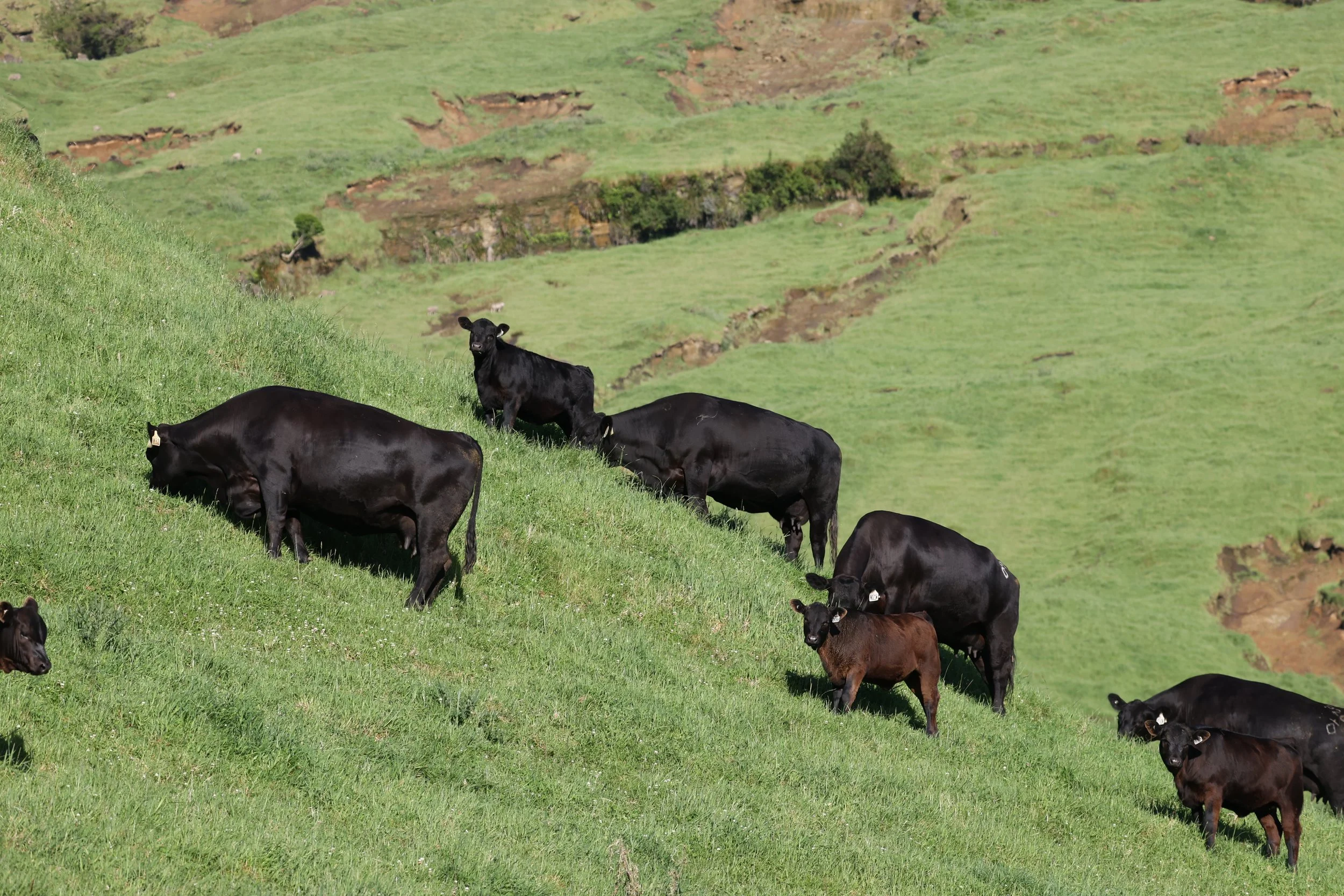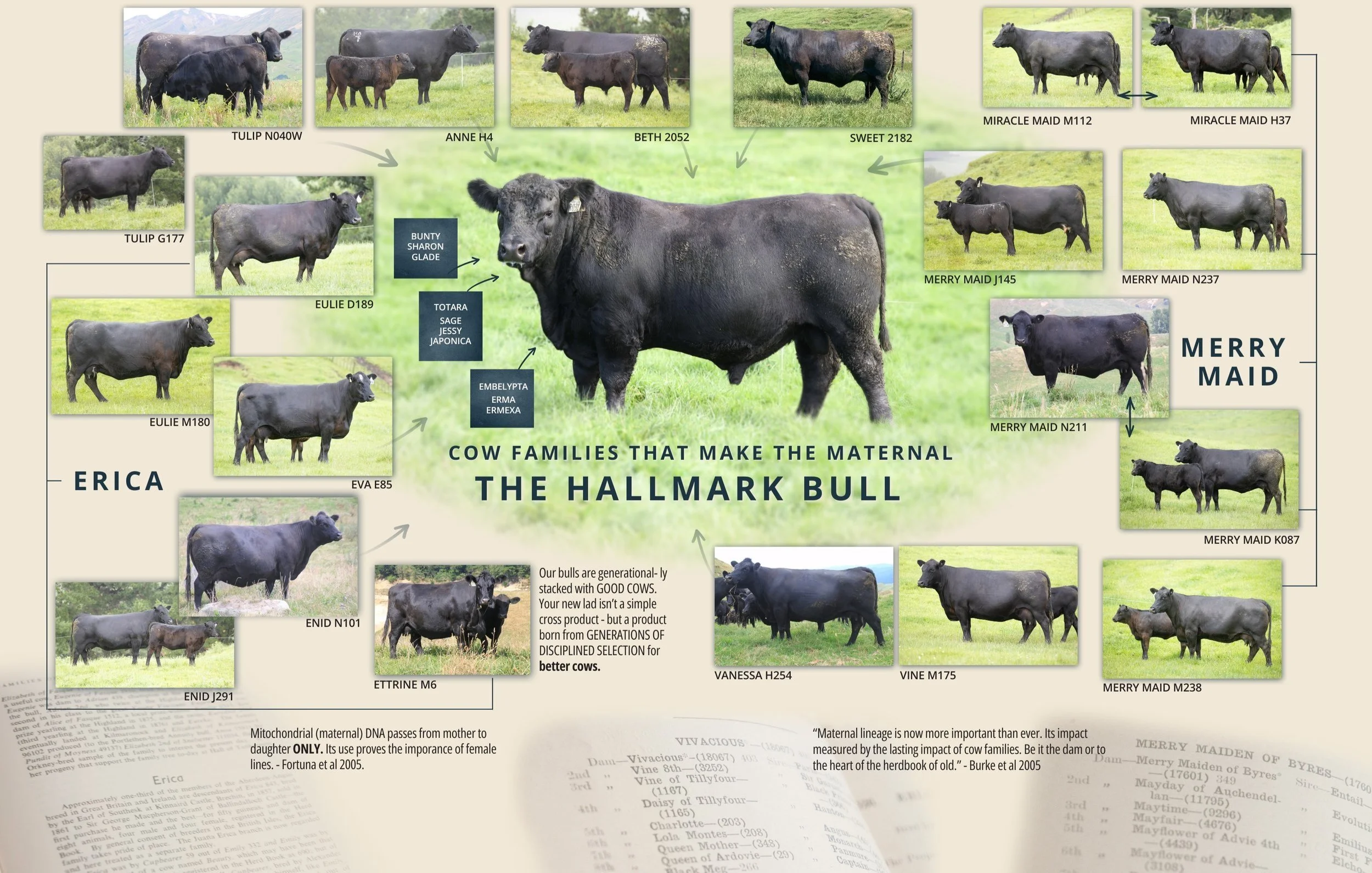A Modern Classic
Hallmark is unashamedly cow focussed. We are driven by the reward of genuine improvement of cows for New Zealand hill country. We believe this discipline and focus on the lowly heritable, hard to record, (but high reward) traits in the maternal environment are the next true frontier in cattle breeding.
This is now so acutely important as we fight land use change and financial relevance in a time where reward is found with other stock classes (and uses) for our class of country. This means our fight to prove the relevance and viability of the New Zealand hill country cow is more important than ever. This focus for the reward of a better cow, fit for purpose – weaning more, heavier, earlier calves year in year out. The productive cow that lasts a long time and holds her condition whilst pushing in to hard country to clean up, still producing a calf that excels at finishing. This reward is THE MODERN CLASSIC.
We have a strong belief in and focus on structural soundness and environmental suitability. Functional cattle cover country with ease and will last for a long time, in delivering their genes to the next generation. It often feels that we are at a time in history when more is always better (more growth, more calving ease, more carcase etc.) we believe that form must follow the function. Our animals must have the sort of type and kind to deliver the improved performance we have selected for. We won’t accept a new ute with all the extra features - that we’ve had to well pay for - to break down or fall apart in the first 100,000 kms, so why should we accept it in our cattle? At Hallmark we are happy to accept a touch less performance in order to build a more sustainable cow herd that has right form and function to get the job done.
Building Better Cattle
-
The history behind the herds that make Hallmark is stacked with structure obsessed stud masters. Nothing has changed with the new custodians. Breed leading feet start with breed leading angles. Cattle with the proper locomotion and movement will wear their feet well and evenly. They are far less prone to lameness and injury and will continue to achieve the productive goals of the herd. Lame cattle are so often unsound cattle in the first place [Sitz 2023].
We are in constant review of any given animals’ place in the herd by structural assessment. If they do not maintain soundness or continue to be lame (likely because of poor soundness) then they are culled – with no excuses. We are fussy and proud of it. Docility is included in this.
Cattle are either sound or unsound in our belief and unsound cattle are not available for sale. Bulls that change (following sale) are covered under the Hallmark Angus 3-year guarantee.
-
Udders help to form a clearer picture of maternal performance. We are convinced this a key contributor to cow longevity, calf survival and weaning percentage.
Cows with strong suspensory ligament (udders held tightly to the body) have longer productive lifetimes [Rasby, 2011]. Big bags that knock at the knees don’t always mean more milk. Just as more milk doesn’t mean more calves. We believe ligament is longevity when it comes to udder and maternal performance.
Furthermore, small teats are easy for a calf to attach too at calving. Calves that attach quickly for their colostrum feed can get up and go quickly and have a stronger start to life. Large, pendulous or bottle shaped teats are difficult for the calf to attach too. Often resulting in udder quarters that don’t get relieved. These quarters then dry off and are prone to mastitis. Cows with mastitis are likely to be dry [Buch et al. 2010]. Those that do get in calf are carrying quarters that will not produce milk for their further reproductive lifetimes – which is difficult to identify at any time other than calving as quarters recede. Ultimately this means fewer, lighter calves [Wang et al. 2003].
-
Ratios are an adjusted value that look into the productive merit of a cow within our herd. Because we believe the cow is poorly characterized within genetic evaluation we must look deeper into what value she has at her No1 job – to wean a heavy calf in our system and within our herd. This value makes sure to account for the things that make animals different – it is adjusted. But it doesn’t include heritability so is not strictly genetic, nor does it include pedigree relationships. We don’t believe in raw data, but we do believe in stacking productive cows every generation into our bulls to produce real world cattle.
All scores are actually percentages. So a ratio of 108% is literally 8% above the herd average weaning (with 100% being the average). [Reiling et al. 2022]
If your environment and system can handle more production, seek cattle with higher ratios. Herds that set stock cows at high rates under ewes at calving are unlikely to require sires with high weaning ratios.
In the catalogue you will see it presented as for example; 2/105 – this means she has had 2 calves at (on average) 5% above the herd average.
-
Early conceiving females wean heavier calves and have more productive lifetimes [Smeaton etal. 1986]
Our goal is to be breeding all 1st cycle calving females. It’s a lofty goal - and probably unachievable for the required feeding, but it is an ambitious one. Having cows that maintain close to a 12 month or 365-day calving interval is the ultimate in a cowherd. Tuning our cow herds to have tight calving intervals with 45 days or less exposed to the bull is where we will maintain the relevance of the Angus cow.
The current EBVs are limited and of low heritability, we use them but also look deeper to within herd, real word production to give us a clearer picture for advancing the most important trait in the cow/calf section of industry – fertility. [Morris et al. 2016]
-
The Hallmark herd has always culled dry cows. It has always mated heifers. It has at times retained wet/dry cows that have not reared a calf (though scanned wet) where the cow has good reason to be retained. The Waiterenui herd had drought in 2010, 2011 & 2012 and then again in 2014 & 2015 followed by 2019, 2020 & 2021 droughts. As a result the Q and R crop of heifers weren’t mated as yearlings. Both groups approached mating at 190kgs - weren’t supported with supplementary feed and were simply too light to take the bull. There have been cows during drought years that have fallen out and sparingly given a 2nd chance but never a third. The policy with the new programme is to supplementary feed as a commercial herd would - to allow target weights to be met, but continue to challenge the cows where possible.
-
KIND: We love capacious cattle with width and length, without extra frame but with extra deep middles that spring from the spine. Strong Angus breed character and heads indicating an early maturity pattern. Medium bone with long quarters, extra muscle and thickness - without tipping the balance. Animals with pliable skin that have a presence and a quality of ‘doability’ to them – that doesn’t need to be expressed by heaps of feeding. Minimal white – or at least not in front of the sheath, although Angus cattle have always had some white. And finally sex character, masculine bulls and feminine females that have the type and kind aforementioned.
-
We firmly believe in ‘the mandate to measure’. We must measure to manage and measure to improve. EBVs are a key piece of that puzzle and we are big believers in their value. We record all traits available to Angus New Zealand breeders as well as those that aren’t like Body Condition and Structural traits. Hallmark has been doing full herd DNA testing for parentage since its inception. Full herd genomics (for the enhancement of EBVs) has been completed for the last 4 calf crops. This is key to building data integrity.
We use and select on the EBVs in our breeding objective. In saying this, some EBVs are better than others. Some are lowly heritable or are simply indicator traits. Others don’t fit our breeding objective. We believe in balance and moving animals forward on as many traits as we can without tipping the balance point to break the fundamentals. This tempered approach comes with much thought and is founded in Max Tweedie’s 5 years in Beef Genetics research and development for Beef + Lamb New Zealand Genetics as National Beef Lead.
— What Does Maternal Mean To Us?
“It’s that sound-as-a-bell, low fuss, get it done on bugger all, fiercely protective (yet gentle to handle) goldilocks milking, whoppin calf bringing, high condition, early breeding, matronly - powerhouse mother. She does year in year out, regardless of the country or the pressure - for aaaages.”
Mitochondrial DNA & Cow Families
The family name is reached by tracing only the bottom (female) line of the pedigree. Which ultimately relates a family back to a single foundation cow - ‘The Matriarch’. When a new Matriarch worthy of her own significant acknowledgement arrives - we may branch or create a new ‘sub-family’. This is always of huge satisfaction to a breeder - founding ones own family of significance.
Modern genetics would throw out cow families as irrelevant. It would argue inheritance (without genomics) is simply passed down 50% from each parent. It suggests dominant cows and their families are not more pre-potent - nor is it of extra benefit to have them in a pedigree, or is their experience or the effect of environment (drought, abundant feed etc) and impact on future crops of calves. However! Mitochondrial DNA would argue otherwise. In fact - Fortuna et al 2005. showed an increase in accuracy on trait estimation for genetic evaluation by accounting for Mitochondrial DNA. It looks to female lines to reveal a clearer picture.
Mitochondrial DNA passes exclusively from mother to daughter It is passed on to sons, but sons cannot pass it on to their own progeny. Therefore, we can follow female lineage by simply tracing Mitochondrial DNA back through the single bond of mother to daughter indefinitely. It is through the experience of these animals and the patterns of mutations - some of which happened hundred of years ago and others a single generation back, that we can see and infact define these mother to daughter cow families. In this we prefer to call it ‘Maternal DNA’ or even ‘Cow Family DNA’.
Were master breeders and founders of Angus - Grant, Watson & McCombie aware of Maternal DNA? Probably not. But they did understand the lasting influence of the mother daughter bond and so established the maternal family naming system. They established the most dominant and versatile breed in the world using this system. Burke, Schaff & Haag 2005.
The incredible story of Miracle Maid 352
Two days post calving Miracle Maid 352 went down with a touch of milk fever, and wouldn’t get up. She was on her tenth calving so was in with the other fifty or sixty ‘geriatrics’ calving right next to the homestead. She was one of those likeable cows – agreeable, proficient and sound – now a matriarch. She had good breeding – Westwind Rito 8503 x Wharekowka Mate on the sire side - we liked immensely, out of an 036 going back to a Traveller 23-4 on the dam side.
She got crook in a great spot – sheltered under trees, protected from the South, on a lean and catching the morning sun, but she wouldn’t get up. We haven’t got faith in clamps or slings, don’t believe in them, so we just left her there. She grew to love her drenches of molasses water, handfuls of special hay, and a scratch. She became incredibly docile, but she wouldn’t get up, so we left her. (We had taken her calf away from her not long after she went down, and started bottle feeding it no problem at all). Day after day we kept up our routine – molasses, hay, water and a scratch – but she still wouldn’t get up. So we left her.
On day ten she got up! Couldn’t believe it! She seemed okay, got stuck into some grass, learnt how to do things again. On day 14 we walked her out of the geriatrics to join some wet/dries. As we were coming to pass the homestead cattle yards her calf numbered K18 (as all bottle fed calves do) called out - “Mummy?!” where-upon (instantly in a resumption of the maternal flood) 352 quickened her pace and called and called and called “yes, it’s me”, “it is me”, “it’s ME!” and the two of them proceeded through the post-partum procedure again with vigour.
Amazingly she returned to full milk and the two of them never looked back. Our 352 had five more calves without incident – a true Matriarch.
- Will MacFarlane, Waiterenui Principal
See the bulls driving genetic gain.





